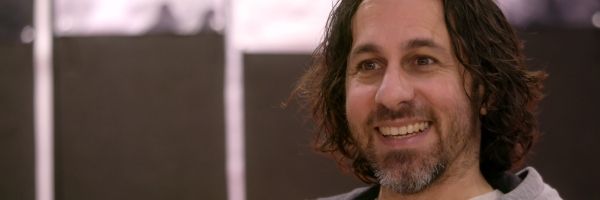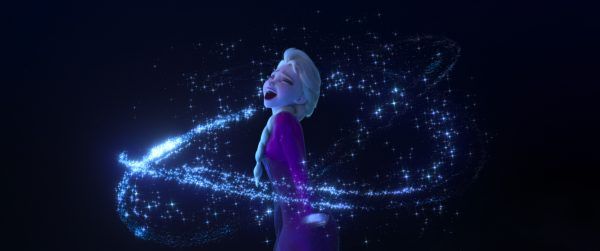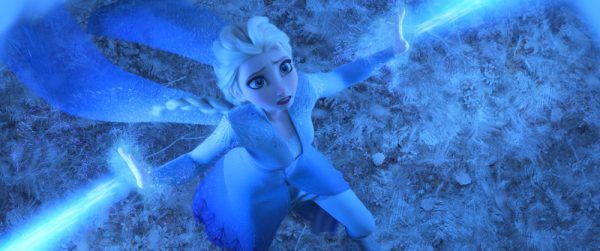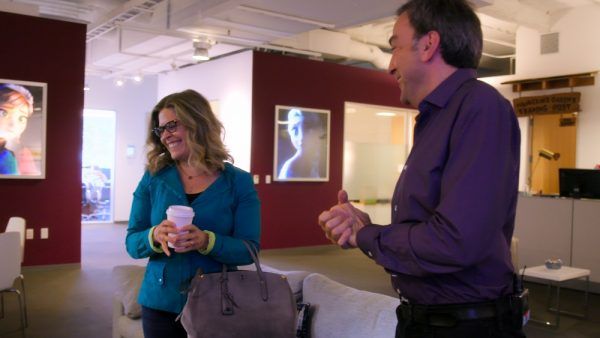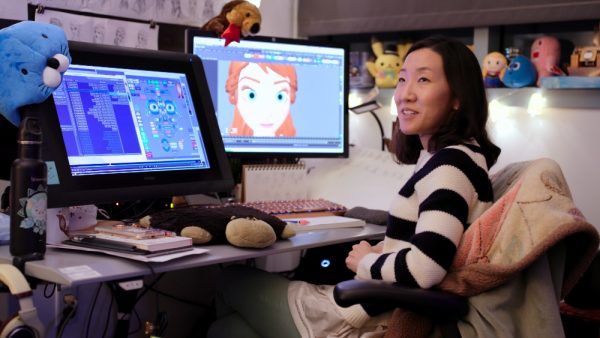Marc Smith has a storied history at Disney Animation. He began work as an intern at the Florida animation satellite studio, housed inside the Magic of Disney Animation attraction at what was then a young Disney-MGM Studios (now Disney’s Hollywood Studios), working as a in-betweener on Pocahontas and The Hunchback of Notre Dame, before graduating to a full-fledged animator on Hercules and Tarzan. After Chicken Little, he moved to the story department for Tangled, eventually becoming director of story on Frozen 2.
Frozen 2, of course, wound up being the biggest animated movie of all time, a genuine phenomenon that eclipsed the sensation surrounding the first Frozen even. Frozen 2 is also the subject of a truly captivating documentary series on Disney+, called Into the Unknown: Making Frozen 2 (all six episodes available now). The filmmakers behind Into the Unknown captured the stressful last year of production before Frozen 2’s release, with key plot points, songs, and character moments still needing to be finessed and worked through. And wouldn’t you know it, Marc is one of the main characters!
So it was a real thrill to get to talk to Marc about what it was like working with a camera crew over your shoulder, what he thinks audiences will get out of the documentary, and whether or not he’s the right man to tackle directorial duties on the as-yet-unannounced and all-but-inevitable Frozen 3. We also asked how close the castle got to actually being wiped out by that giant wave at the end – and the answer might surprise you. And if you want more Into the Unknown goodness, please check out our chat with the documentary’s director, Megan Harding, right here.
How’s it been during quarantine? You guys are, are working straight through, right?
SMITH: Yeah, I had not even a half-a-day glitch. What I'm working on now, it was easy to go straight to home. It was not a problem.
When did they sort of come to you say, “We're thinking about putting a camera crew in here with you?”
SMITH: Well, I don't know when they Peter [Del Vecho], our producer. I just remember maybe a couple of days before the camera crew set up and him saying, “Oh, we're going to have camera crews in all of our meetings. They're going to follow you guys around for a year.” Wow. Okay. But know it was fine. Everyone was lovely. It was a great crew, a great team. We got pretty used to it pretty fast.
Animation is sort of a secretive profession. What did you think of having the whole process for out in the open?
SMITH: I mean, they, they would tell us that they didn't know a lot of the things that were going on behind the scenes with us. It's just, for us it always felt like, Oh, that's just work. So it was interesting for me to think about the things that were interesting to them, if that makes sense.
So much of the show is centered around getting the “Show Yourself” musical number (and the song) right. Can you talk a little bit about that process from your point of view and what it was like during all of that?
SMITH: I mean, these movies are always much harder than they look. Even for us, we wrestle with things for years. And then when we see it up on screen, when it's out or the audience or when we're at the wrap party, I'll just look so easy. You say, “Oh, that all worked.” So on “Show Yourself,” it was a little bit of an outlier in that it was the culmination of Elsa’s arc for not just Frozen 2, but also going all the way back into the first Frozen. It really started back, two movies ago. So that's why that one really took a lot of massaging and a lot of dialing in to get it to where it felt emotionally satisfying as the end of her arc.
When did you guys feel like, Okay, we've got it, we can stop sweating?
SMITH: I mean, it's always close to the pencil down moment. I don't know if it's because you always are pushing to make it better until someone takes it away from you or if it just somehow always mysteriously works out at the end. I’m not sure. It just does.
The other amazing part of the documentary is how it goes really dives into the filmmakers’ lives. Did you know that the stuff was going on while you were making the movie or was it news to you?
SMITH: I knew that the crew was, was traveling to some homes. They came into mind one day. But I didn't know what they were talking about, you know? So, so when Chris and Shelly, his wife, were very open and honest about losing their son, I didn't realize it was going to go to such a deep place. I think it's a testament to Chris for letting them do that.
Was there any part of the process that you’re really excited about people seeing?
SMITH: I hope that people will understand how collaborative a process animation is. Because I don't know that everyone understands that. With live-action movies, although I don't work in live action, my understanding of them is very different. Our work depends so much on the collective group, we really work together, and everyone seems to raise it up as it goes down through the departments. The work just gets better and better and deeper and deeper. I'm hoping that the collaboration of animation will show itself and the value of that.
You’ve been at Disney Animation for at least two eras and weathered the in-between time after the Disney Renaissance and before Disney Animation’s big comeback. Where do you think the studio is now?
SMITH: I think we're an incredibly strong studio at this point. I'm really proud of the level of artistry that's coming out of the studio. Because I did live through a few different eras and I remember in 2D, I felt like we were firing on all cylinders right before, right before two days sort of, you know, at least 2D went to the back burner a little bit. So it's really nice to see the studio, over the last few films or just seem to be getting progressively stronger. And I think Jen's great. I love working with Jen. She's very open and honest and she's very much goes by the old directive of a filmmaker driven studio. I also am happy about the diversity in stories that, that we’re telling. We do have Frozen, but we also have Big Hero 6, you know? There's a lot of things, coming up on the slate that I'm really excited about. I'm really happy about it if it wasn't for all this COVID stuff, I’d even more jazzed.
I think part of the testament to the studio is even though that we're not even in the same building together right now, it doesn't seem to be affecting the work that I'm seeing, in screenings and in films. So yeah, I think, I think we're in a good place.
Well, one of the projects coming up is your directorial debut. Is that still on the table? Have you gotten a documentary crew together to follow its production yet?
SMITH: No, no, no, I am in early development and I think that's about all I can say, but yeah, it's still going forward.
One could argue you are the heir to the Arendelle throne. Should there be a third Frozen, is that something that you're interested in or have talked about at all?
SMITH: We have not had that discussion. I think Frozen 2 is still too close to everyone's minds and ideas to, to think about what happens beyond, beyond that.
Would you be opposed this kind of behind the scenes look at whatever you do next?
SMITH: No, I wouldn't be at all. I have no problem with that. You know, sometimes it's a little therapeutic. You get to verbalize things that normally just happened to you. So you'll sit in an office and have a film crew psychologize you a little bit by talking about it. You get to think about it a little more and get a little more emotional about it. So no, I have no opposition to that.
Were you surprised by anything that made it into the documentary?
SMITH: I wouldn't say I was really surprised but I'm actually happy that some of the moments that were a little more tense, where you see that things aren't working and that they have to be overcome ... I'm, I'm happy that those moments are actually in there. I could see a version where they edited all that stuff out, but then I don't think you'd get a real accurate view of what the working situation is. I'm happy that they stayed true to what it feels like to work that out.
How close did you get to actually destroying the castle?
SMITH: There were conversations about everything over four years. Every idea is tested in the minimal version of that idea and the maximum version of the idea. And usually it ends up closer towards the maximum. I remember conversations where we talked about, well, what happens if the castle does get destroyed? What does that mean? What does that do to the story? I think in the end, I the decision to let Elsa actually saved the castle was the right one.
Frozen 2 is now the most successful animated film of all time. What has that response meant to you?
SMITH: It's the most rewarding thing in the world for me to go to Disneyland or on Halloween and see kids dressed in our characters’ costumes, because it means there was a connection made there. As an artist, being able to have an audience that you can try to connect with in a way that's meaningful to you. And when that is meaningful to them, there's just really nothing better for an artist. For anyone I would imagine, but I certainly feel that way.
All six episodes of Into the Unknown: Making Frozen 2 are available now on Disney+. For more, you can read our review on the in-depth doc.

